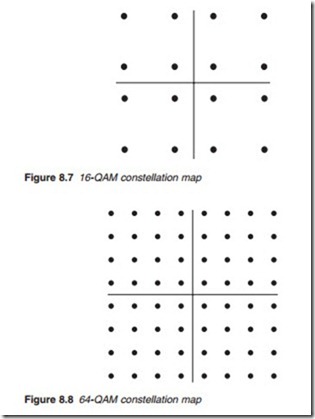Quadrature amplitude modulation
QAM is an extension of PSK in that some phasors are changed in amplitude as well as phase to provide increased bit representation. For instance, 16-QAM encoding increases the bit width of the modulation to 4 as shown in Figure 8.6. Twelve different carrier phasors are used, four of which have two amplitudes to provide further 4-bit combinations. Figure 8.7 depicts all possible carrier phase angles and amplitudes; it is known as a constel- lation map.
A higher order of digital modulation may be employed, for example, in cable, namely 64-QAM encoding, in which each carrier phase/amplitude represents one of 64 possible 6-bit combinations. The constellation map for 64-QAM is shown in Figure 8.8.
Related posts:
VIDEORECORDER DECK CONTROL:CLEAN-EDIT FUNCTIONS.
CONTROL SYSTEMS:MULTI-FUNCTION REMOTE CONTROLLER.
CONTROL SYSTEMS:SCART SYSTEM AND D2B BUS.
TV CAMERAS AND ANALOGUE COLOUR ENCODING:AUTO-IRIS AND AGC.
MPEG encoding:Temporal compression
TEST EQUIPMENT AND FAULT DIAGNOSIS:TRACING INTERMITTENT FAULTS.
AUDIO RECORD AND PLAYBACK:PCM RECORDING.
Audio encoding:Scaling and quantisation
VIDEO ON MAGNETIC TAPE:AZIMUTH OFFSET.
Video re-production:Beam modulation
Magnetic tape recording:The complete VCR and UHF tuner and IF amplifier
DVD:Film grain technology and Interactivity.
Magnetic tape recording:Audio signal processing
TEST EQUIPMENT AND FAULT DIAGNOSIS:PRACTICAL SERVICING.
VIDEORECORDER DECK CONTROL:SYSCON INPUT MATRICES.
